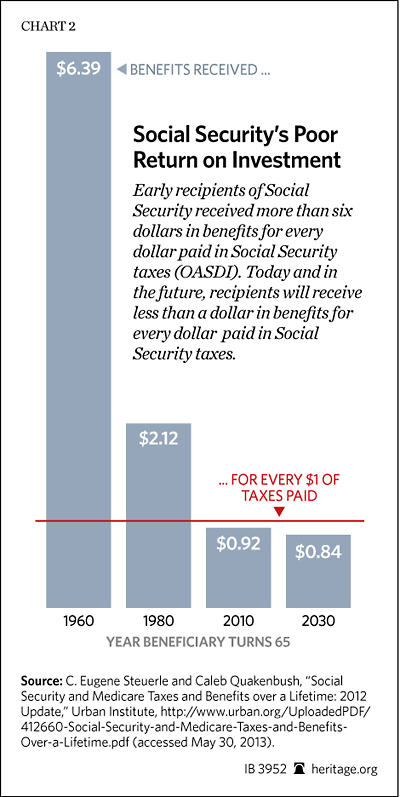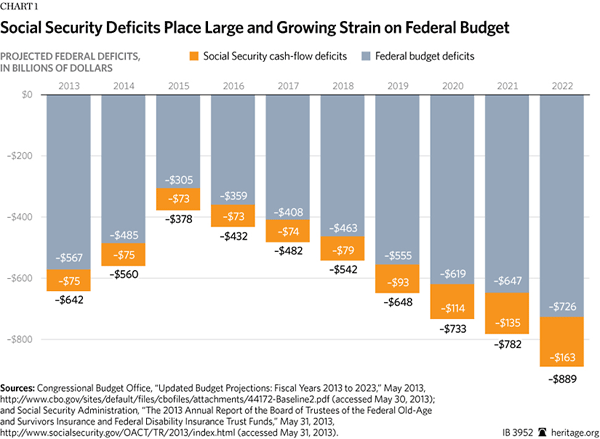Social Security ran a $55 billion deficit in 2012, closing out three years of consecutive cash-flow deficits as the program’s unfunded obligations continue to grow.[1]
The combined 75-year unfunded obligation of the Social Security and Disability trust funds (referred to as the OASDI trust fund) is $12.3 trillion. This is a $1 trillion increase from last year’s unfunded obligation of $11.3 trillion.[2]
The combined Social Security and Disability programs are projected to remain solvent—that is, they are expected to have enough revenue from payroll taxes, interest on the trust fund balance, and repayment of borrowed trust fund dollars to pay out scheduled benefits—through 2033.[3] This is the same date as projected in last year’s report.
If no action is taken to improve the program’s solvency before 2033, benefits will be reduced across the board by 23 percent.
Social Security Is Already Adding to the Deficit
In 2033, the Social Security trust fund will be exhausted, and the program will be able to pay only three-fourths of scheduled benefits. While the Social Security system is considered solvent until that year, this is true only on paper. Social Security already adds to budget deficits.
Since 2010, Social Security has taken in less money through payroll tax revenues than it pays out in benefits, generating cash-flow deficits. Social Security’s 2012 cash-flow deficit was $55 billion.
Social Security covers cash-flow deficits by drawing down interest payments from the U.S. Treasury on previous trust fund borrowing. Cash-flow deficits mean the Treasury can no longer cover interest payments to the Social Security trust fund by issuing additional IOUs; instead, it must produce actual cash from taxes or borrowing. Thus, Social Security is adding to today’s deficits.
What About the Trust Fund?
In the past, when Social Security ran cash-flow surpluses, the federal government spent those surpluses on other federal spending, and in return, the Treasury credited Social Security’s trust fund with special-issue government securities. Although this $2.7 trillion in securities is not counted in the total amount of debt held by the public, it represents real debt that will have to be repaid over the coming decades.[4]
It is true that the Social Security trust fund represents legitimate repayments plus interest, but this distinction has no bearing on the federal budget’s bottom line. Imagine a family that sets aside money for a child’s college education but then borrows all of that money for other spending. Once the time for college arrives, the family will have to scramble to pay tuition because the IOUs in the college account represent money the family must pay itself.
So it is with Social Security’s trust fund. Congress spent all the excess revenues when Social Security was running surpluses, and now repaying those revenues is adding to deficits.
As Chart 1 shows, Social Security repayments represent a considerable portion of current and future deficits.
Earned Benefit or Entitlement?
Past and current retirees receive more in benefits than they paid into the system.
An analysis by the Urban Institute revealed that an average-earning male who reached age 65 in 1960 received $6.39 in Social Security benefits for every dollar he paid in Social Security taxes. This ratio has declined over time to $2.12 for workers who reached age 65 in 1980, 92 cents for workers who reached age 65 in 2010, and 84 cents for workers who will reach age 65 in 2030.[5]

As Social Security has shifted from a program to protect the elderly from poverty to a potential decades-long income subsidy, current workers and younger generations will inevitably bear the burden of Social Security’s drain on the federal budget. Raising payroll taxes on today’s and tomorrow’s workers to cover Social Security’s funding shortfall would only add to their burden.
Three Social Security Reforms
To address Social Security’s massive and growing cash-flow deficits, lawmakers should immediately pursue three important reforms:
- Fix Social Security’s cost-of-living adjustment. Social Security’s cost-of-living adjustment (COLA) is based on an outdated measure of changes in the cost of living that fails to account for how people react to changes in prices. Lawmakers should index Social Security’s COLA to the chained Consumer Price Index (CPI), which acknowledges that people choose less expensive and different goods and services in response to changes in prices. This would more accurately protect the value of benefits while improving Social Security’s finances.[6]
- Increase the early and full retirement ages. Since Social Security’s inception, life expectancy at birth in the United States has increased by about 17 years, while life expectancy at age 65 has increased by about seven years.[7] Yet Social Security’s full retirement age has increased by only two years, and the early retirement age has not increased at all. Social Security’s retirement age serves as an implicit guideline for actual retirement, as more than 70 percent of eligible workers choose to take Social Security benefits at the early retirement age of 62. For Social Security, this means greater financial strain, and for the economy, it means a smaller workforce, lower economic growth, and less revenue. Lawmakers should gradually and predictably increase the early and full retirement ages and then index both to increases in life expectancy.
- Focus Social Security benefits on those who need them most. Social Security was designed as a program to protect the elderly from poverty, yet it pays benefits to more than 47,000 millionaires and leaves many low-income recipients in need of additional welfare benefits.[8] Lawmakers should phase out benefits for retirees with high levels of non–Social Security income and provide a true system of social insurance that focuses on seniors who need it most. Lawmakers should also consider a minimum flat benefit level to protect all seniors from poverty in retirement.
Social Security Needs Reform Today
Social Security is already placing an increasing burden on the federal budget, and all beneficiaries face a 23 percent benefit cut at projected trust fund exhaustion in 2033. Action should be taken today to protect Social Security’s most vulnerable beneficiaries without burdening younger generations through tax increases.
Lawmakers should immediately replace the current COLA adjustment with the more accurate chained CPI, raise the early and full-retirement ages gradually and predictably, focus Social Security benefits on those who need them most, and alleviate poverty in old age with a minimum flat benefit.
—Romina Boccia is Assistant Director of the Thomas A. Roe Institute for Economic Policy Studies and Rachel Greszler is Senior Policy Analyst in Economics and Entitlements in the Center for Data Analysis at The Heritage Foundation.




